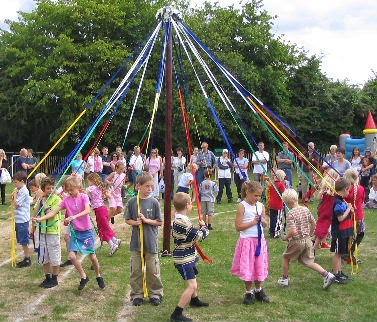The earliest May Day celebrations appeared in pre-Christian times, with the Floralia, festival of Flora, the Roman goddess of flowers, held April 27 during the Roman Republic era, and with the Walpurgis Night celebrations of the Germanic countries. It is also associated with the Gaelic Beltane, most commonly held on April 30. The day was a traditional summer holiday in many pre-Christian European pagan cultures. While February 1 was the first day of Spring, May 1 was the first day of summer; hence, the summer solstice on June 25 (now June 21) was Midsummer.
 As Europe became Christianized,
the pagan holidays lost their religious character and May Day changed
into a popular secular celebration. A significant celebration of May Day
occurs in Germany where it is one of several days on which St. Walburga,
credited with bringing Christianity to Germany, is celebrated. The
secular versions of May Day, observed in Europe and America, may be best
known for their traditions of dancing around the maypole and crowning the Queen of May.
Fading in popularity since the late 20th century is the giving of "May
baskets," small baskets of sweets or flowers, usually left anonymously
on neighbors' doorsteps. This particular tradition is one that I learned about after moving to the Dells, because they used to make May baskets at the library as one of their spring craft activities.
As Europe became Christianized,
the pagan holidays lost their religious character and May Day changed
into a popular secular celebration. A significant celebration of May Day
occurs in Germany where it is one of several days on which St. Walburga,
credited with bringing Christianity to Germany, is celebrated. The
secular versions of May Day, observed in Europe and America, may be best
known for their traditions of dancing around the maypole and crowning the Queen of May.
Fading in popularity since the late 20th century is the giving of "May
baskets," small baskets of sweets or flowers, usually left anonymously
on neighbors' doorsteps. This particular tradition is one that I learned about after moving to the Dells, because they used to make May baskets at the library as one of their spring craft activities.Since the 18th Century, many Roman Catholics have observed May — and May Day — with various May devotions to the Blessed Virgin Mary. In works of art, school skits, and so forth, Mary's head will often be adorned with flowers in a May crowning, something they still do at Holy Hill. May 1st is also one of two feast days of the Catholic patron saint of workers, St Joseph the Worker -- a carpenter, husband to Mary, and surrogate father of Jesus. Replacing another feast to St. Joseph, this date was chosen by the Pope Pius XII in 1955 to create a counterpoint to the Communist International Workers Day celebrations on May Day.
Beginning in the late 20th century, many neopagans began reconstructing traditions and celebrating May Day as a pagan religious festival.
And if that isn't more than you wanted to know about May Day, I don't know what is.
Oh, yeah! The distress call -- Mayday! Mayday! Mayday! -- has been in use since 1923 and has nothing to do with this May Day. It was chosen as an international distress signal for use in radio voice communication that would be easily recognized -- the word is always to be repeated three times -- and comes from the French M’aidez, meaning "Help me!"
Interestingly, to me and Sheldon Cooper, at least, the Mayday procedure word was suggested not by a Frenchman, but by Frederick Stanley Mockford, senior radio officer at Croydon Airport in London.


1 comment:
It is a fascinating story. I hope you have a good 'summer' until Lammas.
Post a Comment